1、为抽象类和接口实例化

抽象类和接口不能直接实例化,因为其内部包含了各个抽象方法,抽象方法本身都是未实现的方法,所以无法调用。通过对象多态性,子类发生了向上转型之后,所调用的全部方法都是被覆写过了的方法。
为抽象类实例化:
abstract class A{ // 定义抽象类A
public abstract void print() ; // 定义抽象方法print()
};
class B extends A { // 定义子类,继承抽象类
public void print(){ // 覆写抽象方法
System.out.println("Hello World!!!") ;
}
};
public class AbstractCaseDemo01{
public static void main(String args[]){
A a = new B() ; // 通过子类为抽象类实例化
a.print() ;
}
};interface A{ // 定义抽象类A
public abstract void print() ; // 定义抽象方法print()
};
class B implements A { // 定义子类,继承抽象类
public void print(){ // 覆写抽象方法
System.out.println("Hello World!!!") ;
}
};
public class InterfaceCaseDemo01{
public static void main(String args[]){
A a = new B() ; // 通过子类为抽象类实例化
a.print() ;
}
};2、抽象类的应用----定义模板
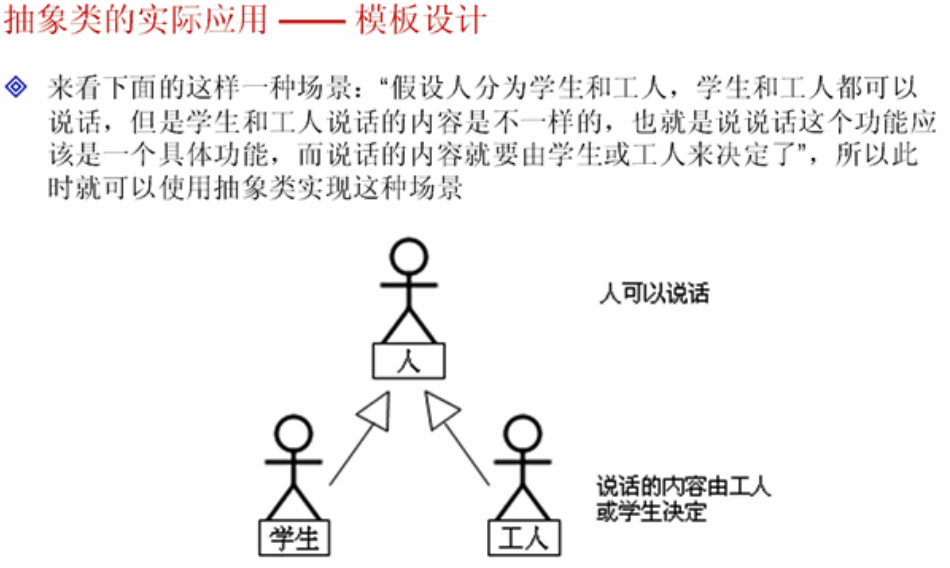
abstract class Person{
private String name ; // 定义name属性
private int age ; // 定义age属性
public Person(String name,int age){
this.name = name ;
this.age = age ;
}
public String getName(){
return this.name ;
}
public int getAge(){
return this.age ;
}
public void say(){ // 人说话是一个具体的功能
System.out.println(this.getContent()) ; // 输出内容
}
public abstract String getContent() ; // 说话的内容由子类决定
};
class Student extends Person{
private float score ;
public Student(String name,int age,float score){
super(name,age) ; // 调用父类中的构造方法
this.score = score ;
}
public String getContent(){
return "学生信息 --> 姓名:" + super.getName() +
";年龄:" + super.getAge() +
";成绩:" + this.score ;
}
};
class Worker extends Person{
private float salary ;
public Worker(String name,int age,float salary){
super(name,age) ; // 调用父类中的构造方法
this.salary = salary ;
}
public String getContent(){
return "工人信息 --> 姓名:" + super.getName() +
";年龄:" + super.getAge() +
";工资:" + this.salary ;
}
};
public class AbstractCaseDemo02{
public static void main(String args[]){
Person per1 = null ; // 声明Person对象
Person per2 = null ; // 声明Person对象
per1 = new Student("张三",20,99.0f) ; // 学生是一个人
per2 = new Worker("李四",30,3000.0f) ; // 工人是一个人
per1.say() ; // 学生说学生的话
per2.say() ; // 工人说工人的话
}
};3、接口的实际应用----指定标准

interface USB{ // 定义了USB接口
public void start() ; // USB设备开始工作
public void stop() ; // USB设备结束工作
}
class Computer{
public static void plugin(USB usb){ // 电脑上可以插入USB设备
usb.start() ;
System.out.println("=========== USB 设备工作 ========") ;
usb.stop() ;
}
};
class Flash implements USB{
public void start(){ // 覆写方法
System.out.println("U盘开始工作。") ;
}
public void stop(){ // 覆写方法
System.out.println("U盘停止工作。") ;
}
};
class Print implements USB{
public void start(){ // 覆写方法
System.out.println("打印机开始工作。") ;
}
public void stop(){ // 覆写方法
System.out.println("打印机停止工作。") ;
}
};
public class InterfaceCaseDemo02{
public static void main(String args[]){
Computer.plugin(new Flash()) ;
Computer.plugin(new Print()) ;
}
};4、工厂设计模式
interface Fruit{ // 定义一个水果接口
public void eat() ; // 吃水果
}
class Apple implements Fruit{
public void eat(){
System.out.println("** 吃苹果。") ;
}
};
class Orange implements Fruit{
public void eat(){
System.out.println("** 吃橘子。") ;
}
};
public class InterfaceCaseDemo03{
public static void main(String args[]){
Fruit f = new Apple() ; // 实例化接口
f.eat() ;
}
};

此过渡端在程序中就称为工厂设计。
interface Fruit{ // 定义一个水果接口
public void eat() ; // 吃水果
}
class Apple implements Fruit{
public void eat(){
System.out.println("** 吃苹果。") ;
}
};
class Orange implements Fruit{
public void eat(){
System.out.println("** 吃橘子。") ;
}
};
class Factory{ // 定义工厂类
public static Fruit getInstance(String className){
Fruit f = null ;
if("apple".equals(className)){ // 判断是否要的是苹果的子类
f = new Apple() ;
}
if("orange".equals(className)){ // 判断是否要的是橘子的子类
f = new Orange() ;
}
return f ;
}
};
public class InterfaceCaseDemo05{
public static void main(String args[]){
Fruit f = Factory.getInstance(args[0]) ; // 实例化接口
if(f!=null){ // 判断是否取得实例
f.eat() ;
}
}
};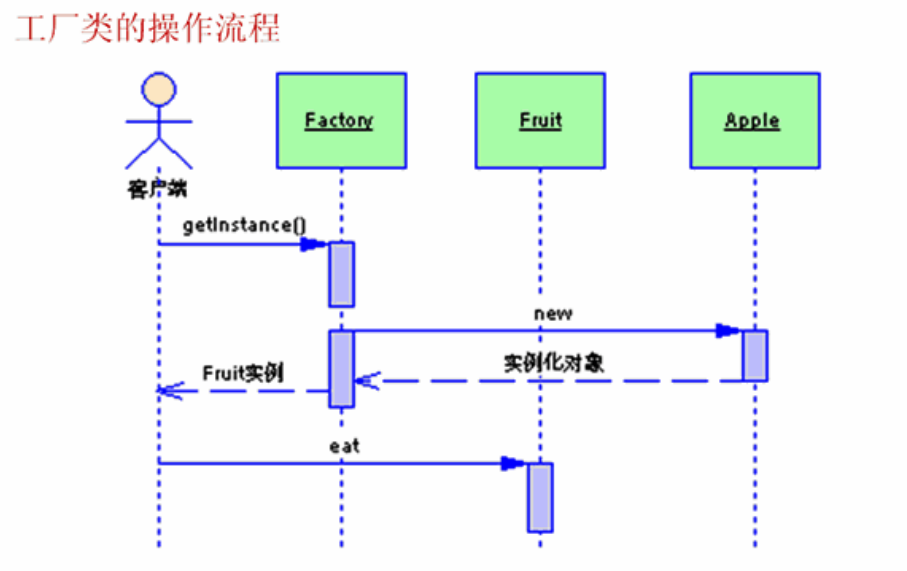
5、代理设计模式
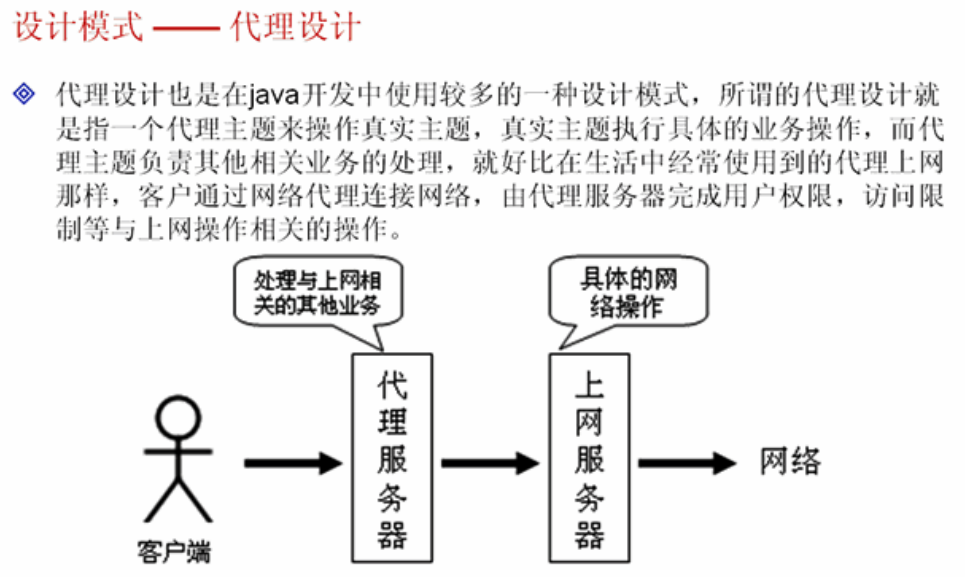
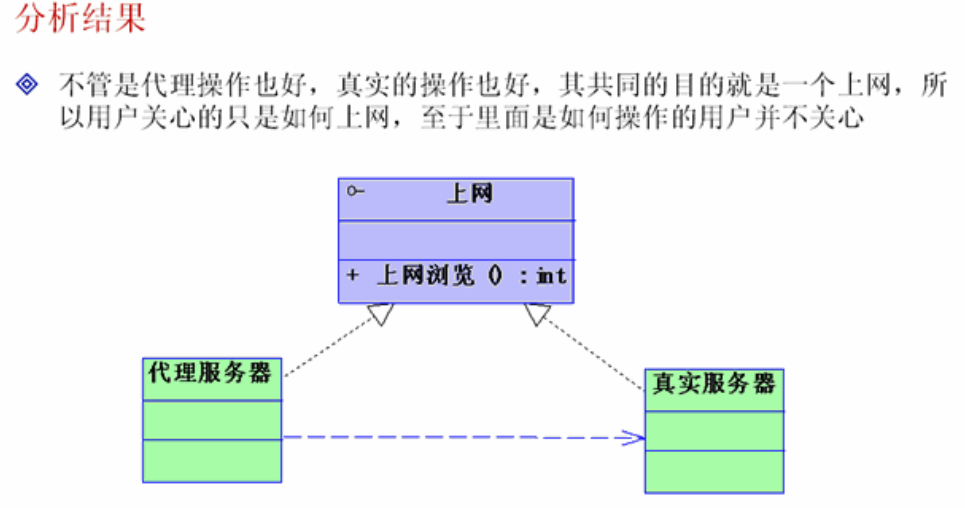
interface Network{
public void browse() ; // 浏览
}
class Real implements Network{
public void browse(){
System.out.println("上网浏览信息") ;
}
};
class Proxy implements Network{
private Network network ; // 代理对象
public Proxy(Network network){
this.network = network ;
}
public void check(){
System.out.println("检查用户是否合法。") ;
}
public void browse(){
this.check() ;
this.network.browse() ; // 调用真实的主题操作
}
};
public class ProxyDemo{
public static void main(String args[]){
Network net = null ;
net = new Proxy(new Real()) ;// 指定代理操作
net.browse() ; // 客户只关心上网浏览一个操作
}
};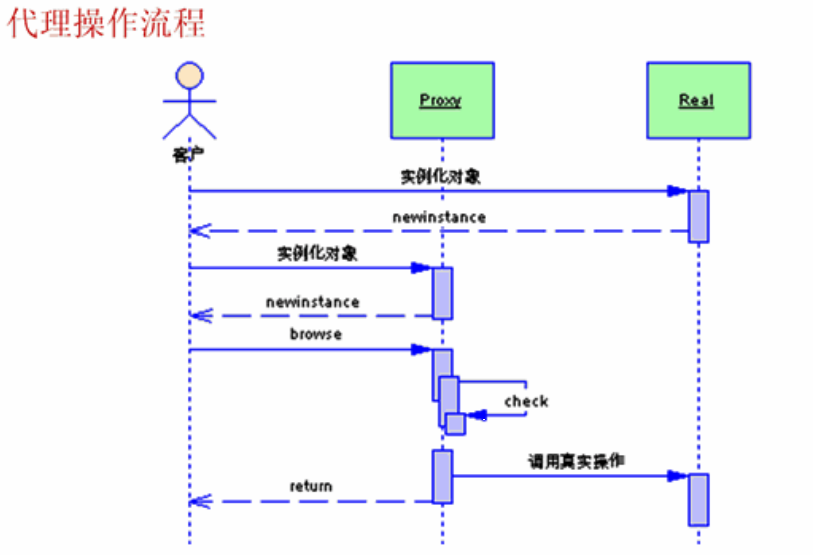
6、适配器设计

interface Window{ // 定义Window接口,表示窗口操作
public void open() ; // 打开
public void close() ; // 关闭
public void activated() ; // 窗口活动
public void iconified() ; // 窗口最小化
public void deiconified();// 窗口恢复大小
}
abstract class WindowAdapter implements Window{
public void open(){} ; // 打开
public void close(){} ; // 关闭
public void activated(){} ; // 窗口活动
public void iconified(){} ; // 窗口最小化
public void deiconified(){};// 窗口恢复大小
};
class WindowImpl extends WindowAdapter{
public void open(){
System.out.println("窗口打开。") ;
}
public void close(){
System.out.println("窗口关闭。") ;
}
};
public class AdapterDemo{
public static void main(String args[]){
Window win = new WindowImpl() ;
win.open() ;
win.close() ;
}
};7、内部类的扩展
抽象类中包含一个接口
abstract class A{ // 定义抽象类
public abstract void printA() ; // 抽象方法
interface B{ // 定义内部接口
public void printB() ; // 定义抽象方法
}
};
class X extends A{ // 继承抽象类
public void printA(){
System.out.println("HELLO --> A") ;
}
class Y implements B{ // 定义内部类实现内部接口
public void printB(){
System.out.println("HELLO --> B") ;
}
};
};
public class InnerExtDemo01{
public static void main(String args[]){
A.B b = new X().new Y() ;
b.printB() ;
}
};接口中定义一个抽象类
interface A{ // 定义接口
public void printA() ; // 抽象方法
abstract class B{ // 定义内部抽象类
public abstract void printB() ; // 定义抽象方法
}
};
class X implements A{ // 实现接口
public void printA(){
System.out.println("HELLO --> A") ;
}
class Y extends B{ // 继承抽象类
public void printB(){
System.out.println("HELLO --> B") ;
}
};
};
public class InnerExtDemo02{
public static void main(String args[]){
A.B b = new X().new Y() ;
b.printB() ;
}
};8、抽象类与接口之间的关系
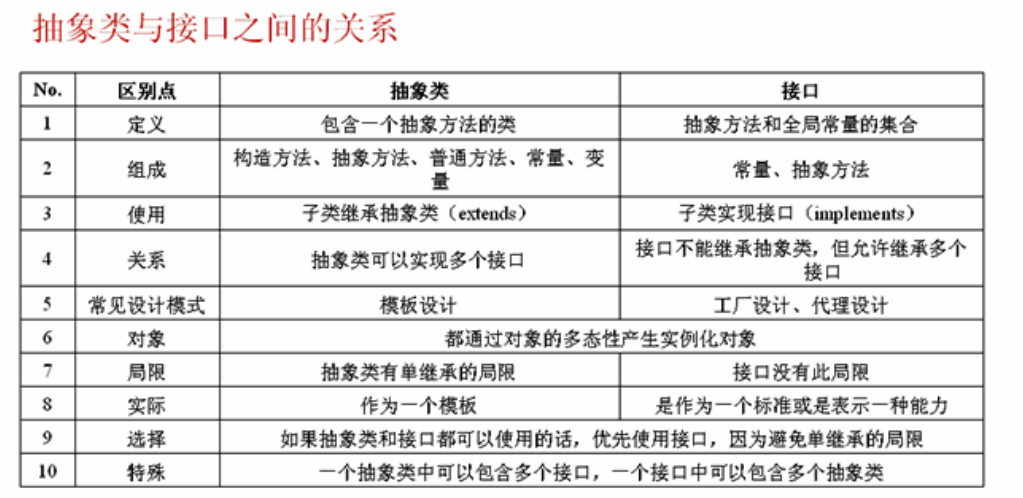
重要提示:在开发中,一个类永远不要去继承一个已经实现好的类,要么继承抽象类,要么实现接口。如果抽象类和接口同时都可以使用的话,那么优先使用接口,避免单继承局限。
























 388
388











 被折叠的 条评论
为什么被折叠?
被折叠的 条评论
为什么被折叠?








